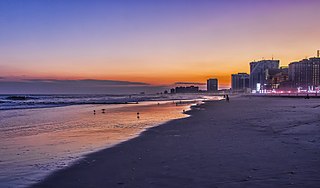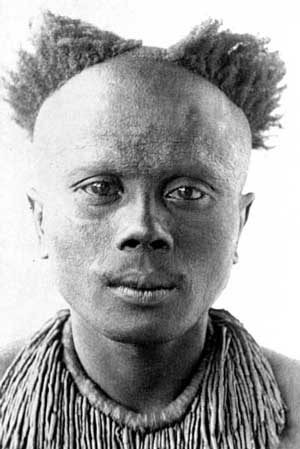
A seaside resort is a city, town, village, or hotel that serves as a vacation resort and is located on a coast. Sometimes the concept includes an aspect of official accreditation based on the satisfaction of certain requirements, such as in the German Seebad. Where a beach is the primary focus for tourists, it may be called a beach resort.
The Andamanese languages are the languages spoken by the indigenous Andamanese peoples of the Andaman Islands in the Indian Ocean. It contains two known language families, Great Andamanese and Ongan, as well as two presumed but unattested languages, Sentinelese and Jangil.

The Pucikwar language, A-Pucikwar, is an extinct language of the Andaman Islands, India, formerly spoken by the Pucikwar people on the south coast of Middle Andaman, the northeast coast of South Andaman, and on Baratang Island. It belonged to the Great Andamanese family.
The Pucikwar were one of the indigenous peoples of the Andaman Islands, one of the ten or so Great Andamanese tribes identified by British colonials in the 1860s. They spoke a distinctive Pucikwar language (A-Pucikwar) closely related to the other Great Andamanese languages. The tribe disappeared as a distinct group sometime after 1931.

The Adivasi refers to heterogeneous tribal groups across the Indian subcontinent. The term is a Sanskrit word coined in the 1930s by political activists to give the tribal people an indigenous identity by claiming an indigenous origin. The term is also used for ethnic minorities, such as Chakmas of Bangladesh, Bhumiputara Tharus of Nepal, and Vedda of Sri Lanka. The Constitution of India does not use the word Adivasi, instead referring to Scheduled Tribes and Janjati. The government of India does not officially recognise tribes as indigenous people. The country ratified the International Labour Organization (ILO) Convention 107 on Indigenous and Tribal Peoples of the United Nations (1957) and refused to sign the ILO Convention 169. Most of these groups are included in the Scheduled Tribe category under constitutional provisions in India.

The Andamanese are the various indigenous peoples of the Andaman Islands, part of India's Andaman and Nicobar Islands, the union territory in the southeastern part of the Bay of Bengal. The Andamanese are a designated Scheduled Tribe in India's constitution.

The Great Andamanese are an indigenous people of the Great Andaman archipelago in the Andaman Islands. Historically, the Great Andamanese lived throughout the archipelago, and were divided into ten major tribes. Their distinct but closely related languages comprised the Great Andamanese languages, one of the two identified Andamanese language families.

The Bale language, Akar-Bale, is an extinct Southern Great Andamanese language once spoken in the Andaman Islands in Ritchie's Archipelago, Havelock Island, and Neill Island.
The Jarawas are an indigenous people of the Andaman Islands in India. They live in parts of South Andaman and Middle Andaman Islands, and their present numbers are estimated at between 250–400 individuals. They have largely shunned interaction with outsiders, and many particulars of their society, culture and traditions are poorly understood. Since the 1990s, contacts between Jarawa groups and outsiders grew increasingly frequent. By the 2000s, some Jarawas had become regular visitors at settlements, where they trade, interact with tourists, get medical aid, and even send their children to school.

The Great Andamanese languages are a nearly extinct language family once spoken by the Great Andamanese peoples of the northern and central Andaman Islands in the Indian Ocean, and part of Andamanese sprachbund.

The Kede language, Aka-Kede, is an extinct Great Andamanese language, of the Northern group. It was spoken in the Northern section of Middle Andaman island.

The Kol language, Aka-Kol, is an extinct Great Andamanese language, of the Central group. It was spoken in the southeast section of Middle Andaman.

The Juwoi language, Oko-Juwoi, is an extinct Great Andamanese language, of the Central group. It was spoken in the west central and southwest interior of Middle Andaman.

The Bo language, Aka-Bo, was a Great Andamanese language. It was spoken on the west central coast of North Andaman and on North Reef Island of the Andaman Islands in India.

The Cari, Chariar or Sare language, also known as Aka-Cari, is an extinct Great Andamanese language, of the Northern group, which was spoken by the Cari people, one of a dozen Great Andamanese peoples.

The Jeru language, Aka-Jeru, is a moribund Great Andamanese language, of the Northern group. Jeru was spoken in the interior and south coast of North Andaman and on Sound Island. A koiné of Aka-Jeru and other northern Great Andamanese languages was once spoken on Strait Island; the last semi-fluent speaker of this, Nao Jr., died in 2009. Aka-Jeru is the last surviving member of the Great Andamanese languages.

The Kora (Cora) language, Aka-Kora, is an extinct Great Andamanese language, of the Northern group. It was spoken on the northeast and north central coasts of North Andaman and on Smith Island.
The evolution of languages or history of language includes the evolution, divergence and development of languages throughout time, as reconstructed based on glottochronology, comparative linguistics, written records and other historical linguistics techniques. The origin of language is a hotly contested topic, with some languages tentatively traced back to the Paleolithic. However, archaeological and written records extend the history of language into ancient times and the Neolithic.





